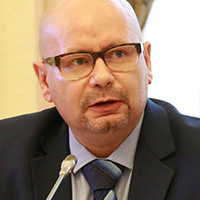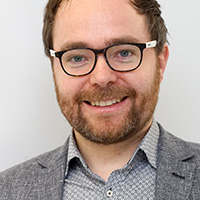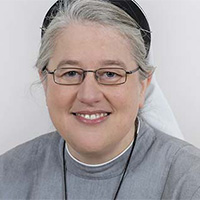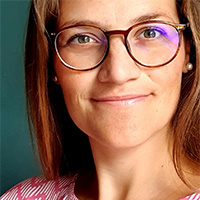27 January, 18:00-20:00
Historical Continuity, New Beginnings and the Formation of Protestant Identity
There are Protestant churches that have shown unbroken continuity since the time of the Reformation. Others, however, have experienced painful breaks and new beginnings in their history. What are the differences in identity formation? What processes have they gone through? The Evangelical Lutheran Church in Bavaria (ELKB) and the Evangelical Lutheran Church in Russia and Other States (ELCROS) will serve as examples:
Church Councillor Raphael Quandt is ecumenical advisor of the Bavarian regional church and thus has insight into ecumenical processes. He comes from a genuinely Protestant region (Franconia).
Dr Anton Tikhomirov is director of the ELCROS theological seminary in St Petersburg and has experienced and shaped the reconstruction of the Evangelical Lutheran Church in the former Soviet Union.
Sr. PD Dr. Nicole Grochowina works at the Friedrich Alexander University of Erlangen/Nuremberg (history and church history); and in 2008, she entered a Lutheran monastery.

Principal Dr. Anton Tikhomirov (ELCROS)
“We have a rich heritage but … we need renewal. … this should be a renewal not only and not so much of church forms, but a perpetual renewal in the spirit of overcoming the dominance of form, renewal in the spirit of the Protestant principle.”

KR Raphael Quandt (ELKB)
“The narrative of coninuity is also disclosed by the fact, that the emerging Lutheran church and the Reformation movement as such were not homogenous at all. In fact an innerevangelical ecumenism was needed right from the start.”

Sr. PD. Dr. Nicole Grochowina (fau)
“Narratives shape identities, since they address the common Questions and desires of the contemporaries.”

Summary
by Dr. Mirjam Sauer (Evangelischer Bund Hessen)
The first part of the lecture was held by Principal Dr. Anton Tikhomirov (ELCROS). It was important for him not to take a dogmatic or church-historical perspective, but the authentic perspective of the Evangelical/Lutheran Church in Russia.
Today, the Lutherans are a vanishingly small minority in a country that has 145 million inhabitants. The between 16000 and 50000 members are sometimes thousands of kilometers apart. The Lutheran Church in Russia has undergone a rapid development from a state church at the beginning of the twentieth century to today’s status quo. This development is characterized by three major hits: (1) the October Revolution and the subsequent persecution of the believers, (2) the beginning of the Second World War and the mass deportation of the Russian Germans to Siberia, Kazakhstan and Central Asia, and finally (2) the opening of the borders and the emigration of Russian Germans. Finally, there is the separation of the Baltic Republic from Russia in 1918 and 1991, which meant the loss of important theological infrastructure. It should not be overlooked that these developments, especially the emigration, partly continue until today. The question of identity and continuity remains.
Tikhomirov made it clear that these shocks and massive experiences of loss have led, on the one hand, to an apocalyptic worldview in the older generations. On the other hand, he sees the possibility, especially for the younger generations, to shape and form church structures and institutions by drawing on tradition and searching for new ways. Regarding the self-understanding and the self-claim of the church, popular church (Church of the Russian Germans) and free church tradition lines (Brethren congregations) are opposed to each other.
Lutheran Protestants today face the tense challenge of combining German and European confessionality with Russian native culture. It is precisely here that Tikhomirov sees a point of connection for the Protestant principle by Tillich. Following Paul Althaus, he also distinguishes between the concrete forms of Christianity and Protestantism and the Protestant principle: the Good News about God’s love and God’s unconditional acceptance of sinners. Tikhomirov argues that this principle should be the core of the church, which presents and shows itself in different forms, each and every time anew.
This is exactly what the Russian Lutheran Church feels and lives – as a church with a rich heritage, which must renew itself each and every time in favor of that Protestant principle as a (Protestant) minority within a (Christian) minority. Tikhomirov proposes to see itself as a minority within a minority, as an enclave of a secular society within a Christian minority, and to advocate renewal within this Christian minority. At the same time, this Protestant minority within the secular society can criticize from a Christian point of view, as part of this society and starting from the Protestant principle. He concluded with a summary statement: “For me to be a Lutheran especially in contemporary Russia means that in us and upon us an ancient and central dream of humanity has been fulfilled – to be accepted by God, forgiven, loved and free from the law and the curse; a dream as ancient and as rooted in our existence as the dream of human flight. Not continuity as such and not the new beginning as such but a miracle that happens again and again.”
The second part of the lecture was given by Sr. PD. Dr. Nicole Grochowina and KR Raphael Quandt from the Evangelical Lutheran Church in Bavaria. In their joint lecture, they explored the question of the importance of and dealing with narratives for one’s own confessional identity. It is the power of narratives to suggest historical continuities by shaping strong master narratives, they said. In three steps they went along the example of Protestant identities: they asked the basic question whether it makes sense at all to speak of historical continuities, problematized in a second step the possibility to speak of a homogeneous Protestant identity and finally concluded that identity is always time- and context-bound.
In reference to German Johann Gustav Droysen, Grochowina and Quandt made it clear that any talk of continuity simultaneously transported a specific theological understanding of history. Droysen had made clear that historians need an awareness of their own subjective perspectives, of their own favored narratives and conceptions of history as an expression of a specific cultural identity. They related this insight to the question of Protestant identity. The question of identity and origin is as old as mankind to find meaning and causality and to gain an understanding of the present.
Based on Luther’s theses, they showed how the idea of continuity was linked with political, strategic and confessional interests – already during Luther’s lifetime and continuing in the Protestant culture of remembrance. In this context, Grochowina and Quandt also addressed the question of historical lines and the specific interests and content-related settings that go hand in hand with epochal demarcations, as could be shown by the example of Luther’s posting of the theses as the moment of origin of the Reformation. They pointed out Leppin’s suggestion to abandon the concept of continuity and to speak instead of a “process of transformation”. This process concept not only leaves behind the alternative notion of continuity or rupture, but also relativizes the uniqueness of Luther as a person.
Against this notion, they argued for the heterogeneity of the Reformation movement, which was also linked to different political interests. If one looks more closely at this Reformation movement and its early development in the territories of the Holy Roman Empire of the German Nation, it is almost impossible to speak of a coherent or even continuous Protestant identity.
In their summary, the two speakers made clear: “Narratives shape identities, since they address the common questions and desire of the contemporaries. Therefore, the question of continuity is closely linked to the efforts to establish identity … Overall, the power of narratives shaping confessional identities shall not be underestimated; Yet they need to be de-constructed.”